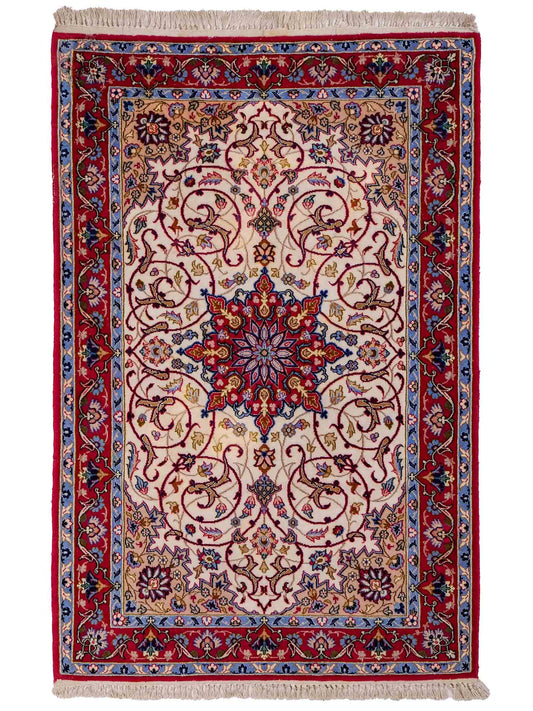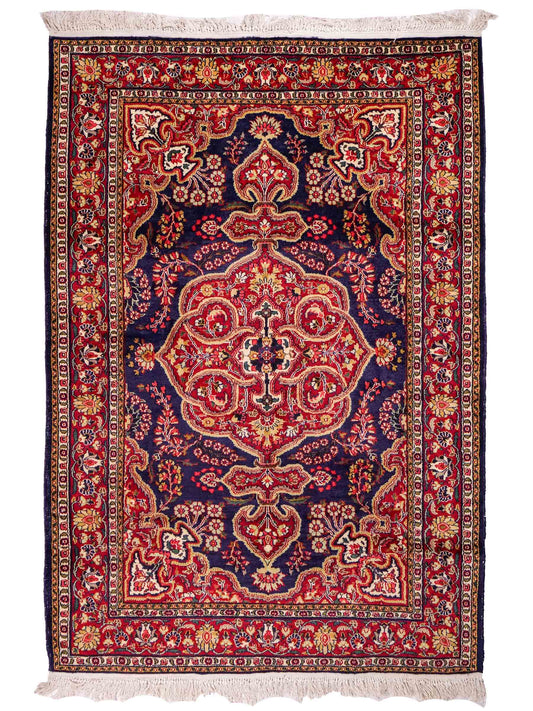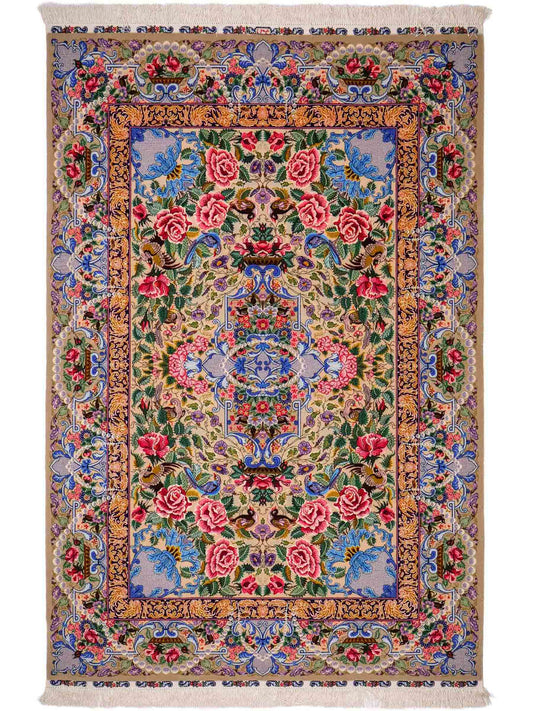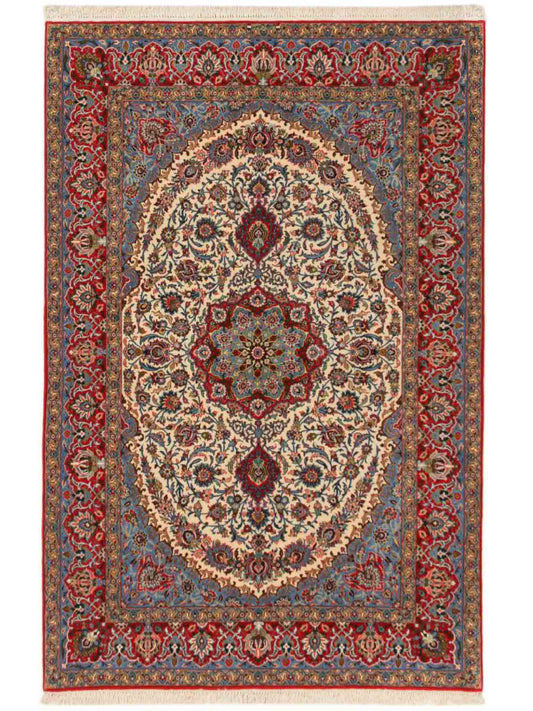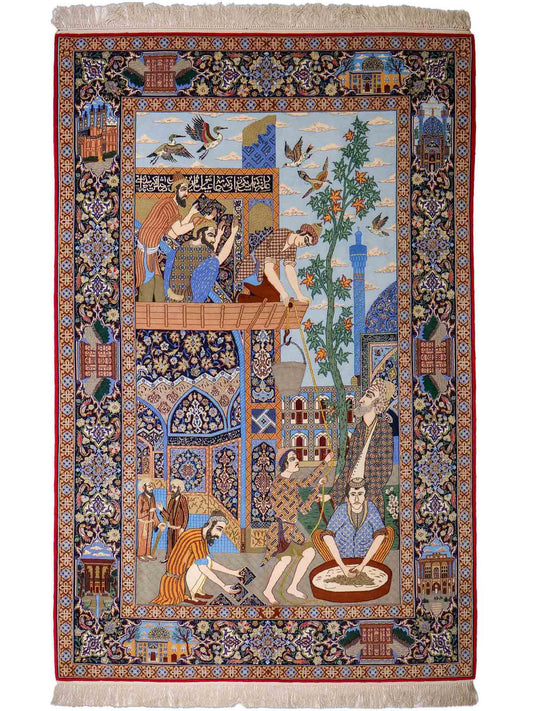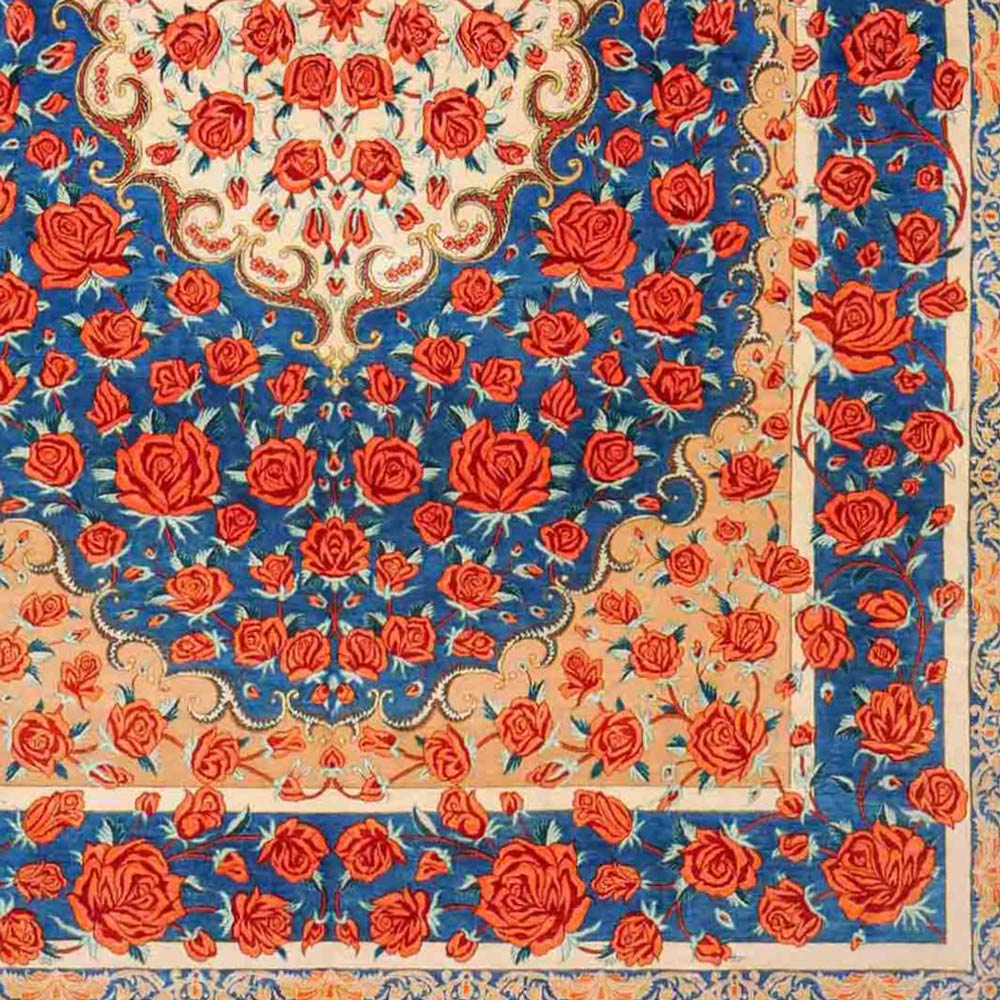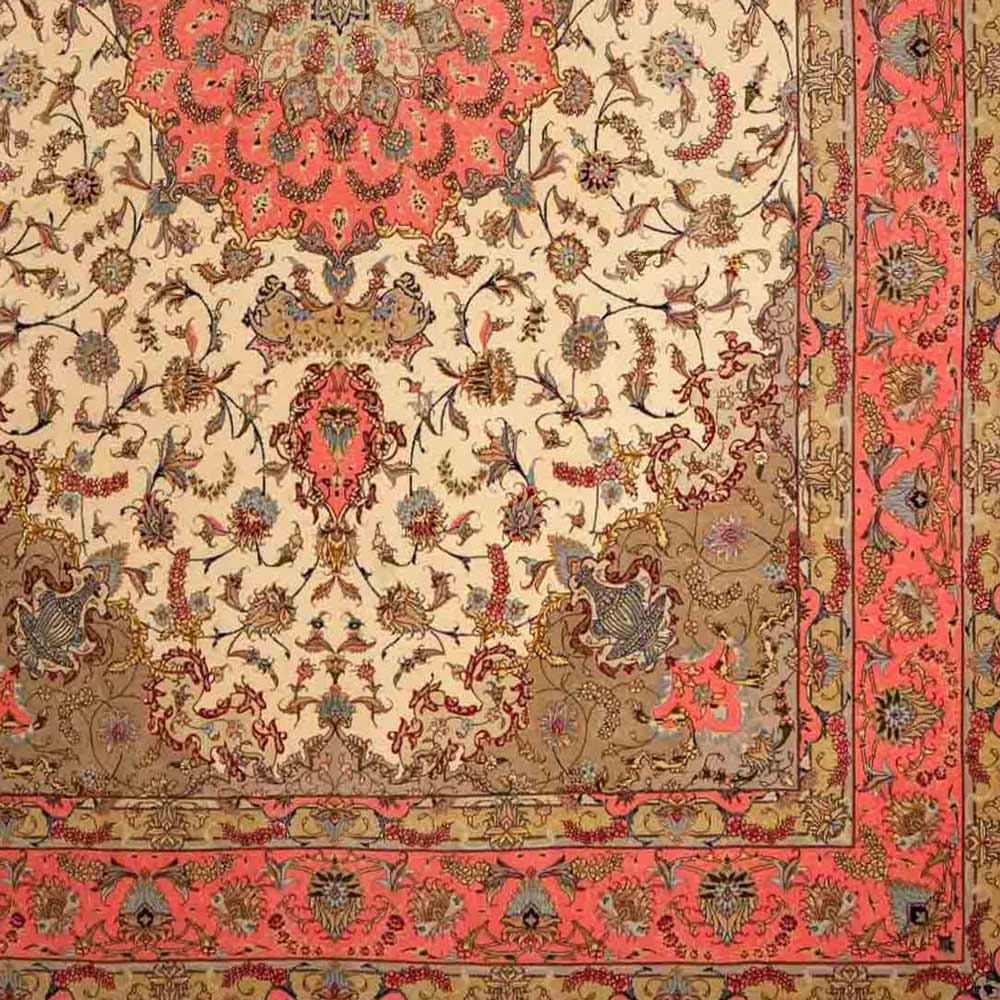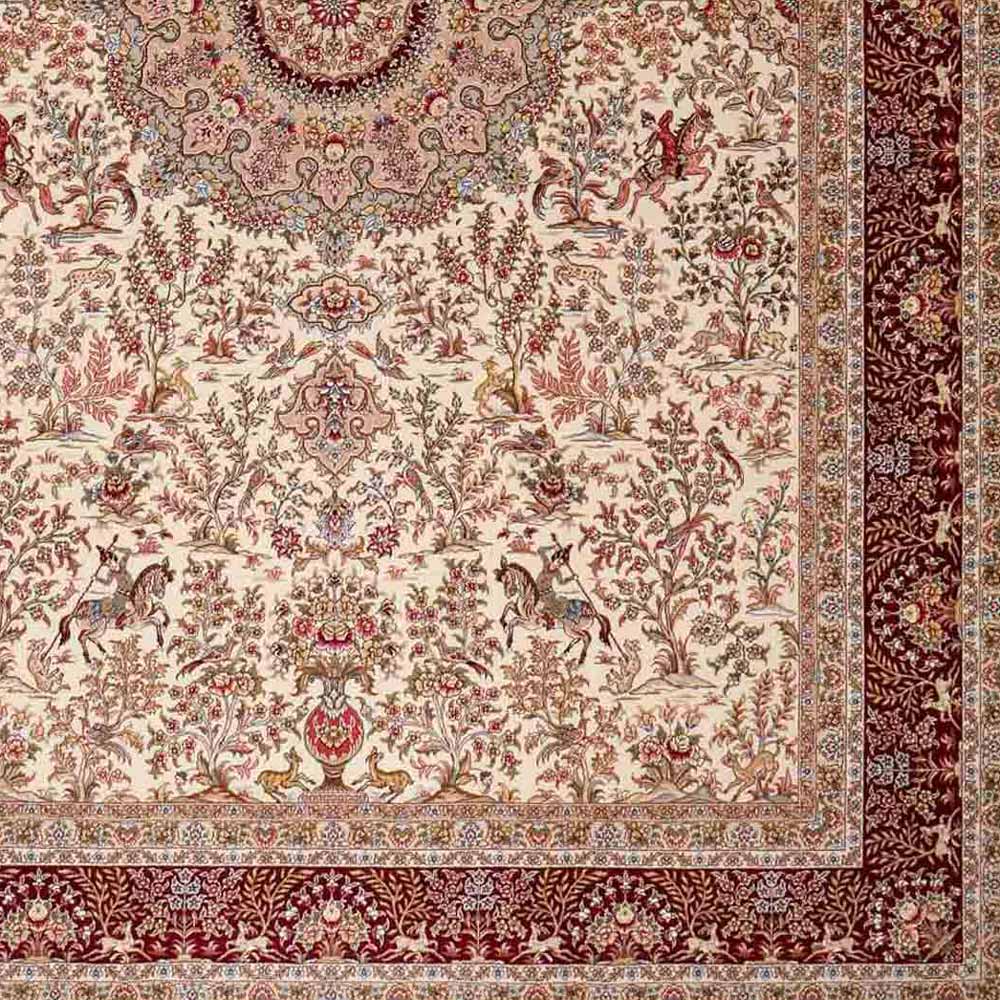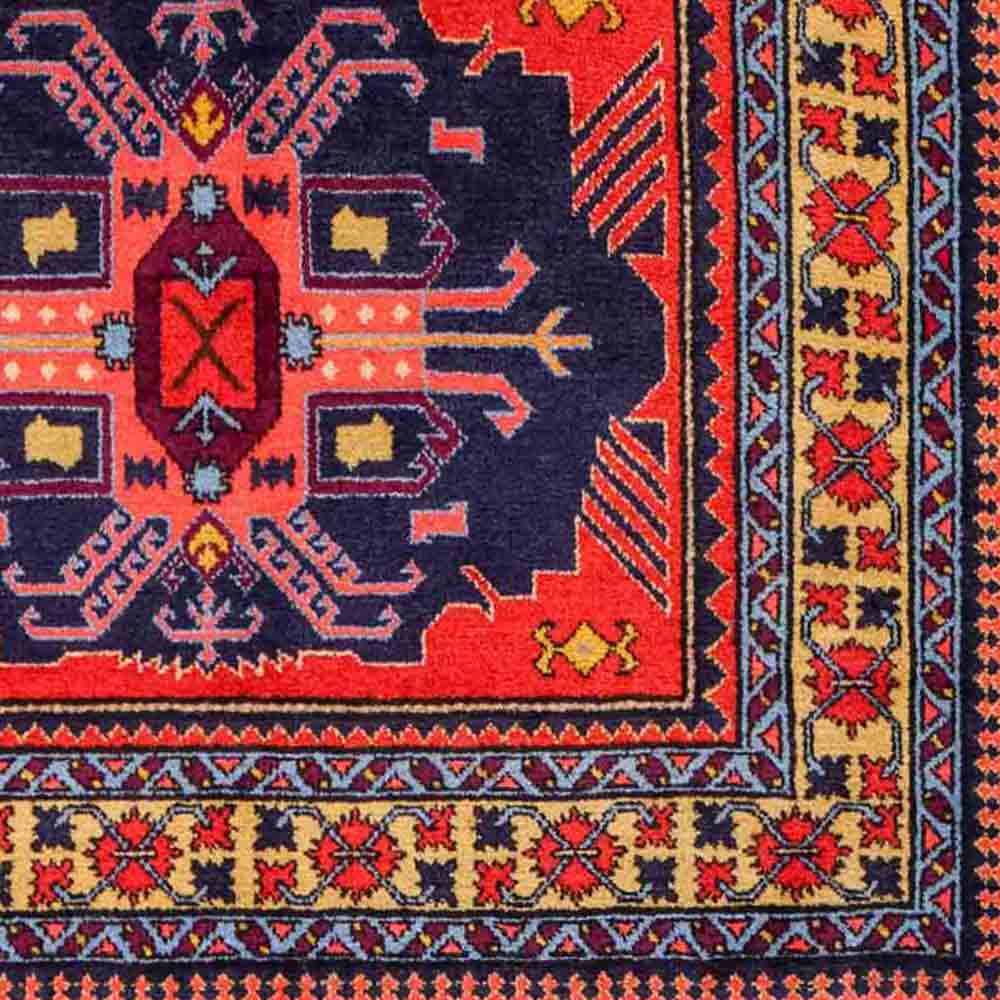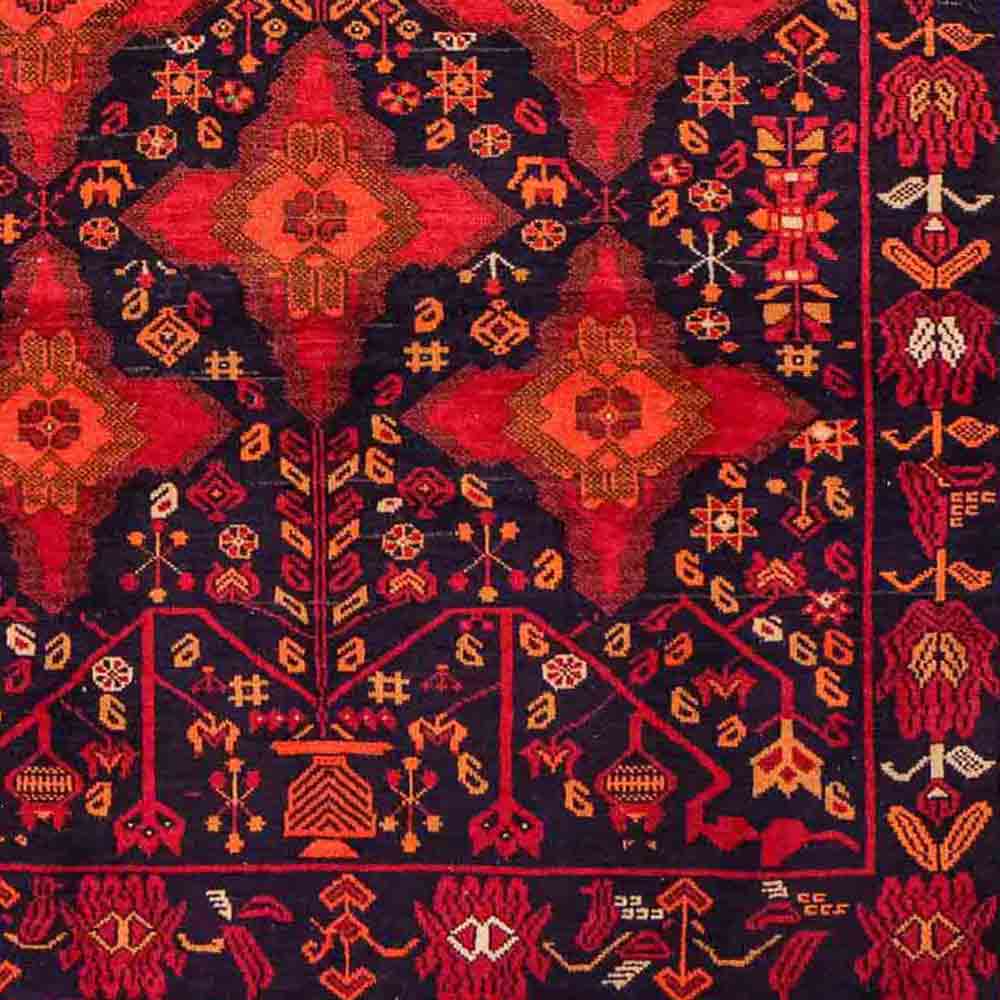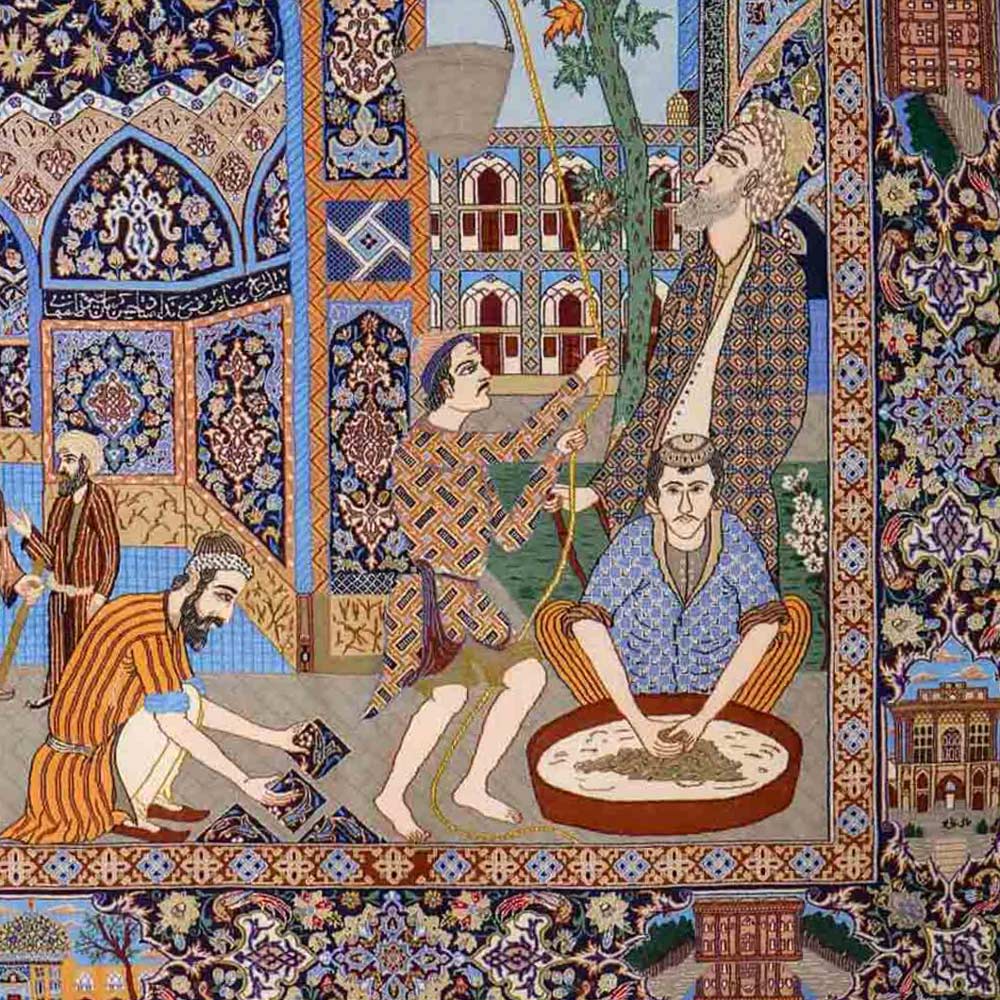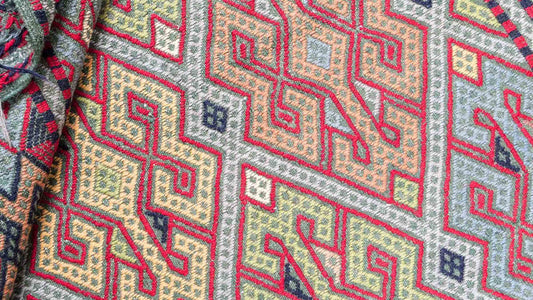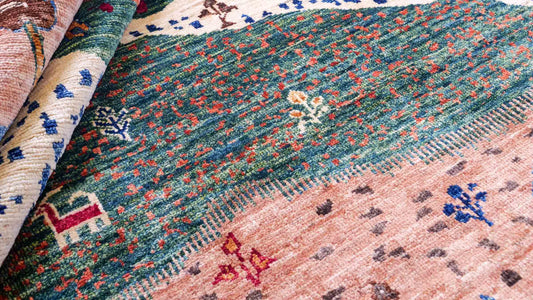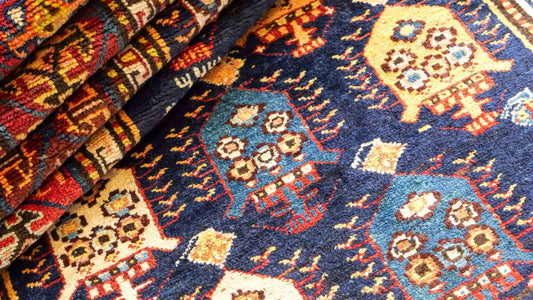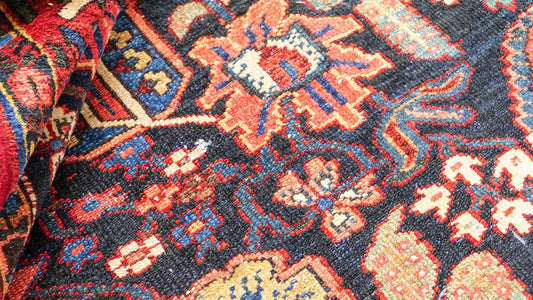
Isfahan
Daniel KhademiIsfahan rugs are the embodiment of Persian artisanal skill. They unite centuries-old tradition with the highest artistic precision, innovative designs, and legendary quality standards. Discover all facets—from history and geography to craftsmanship, patterns, care, interior design, value, and investment potential.
Isfahan Rugs at a Glance
- Origin: Isfahan, central Iran – former capital, center of Safavid culture
- Materials: Fine wool, intricate silk highlights, natural plant dyes
- Designs: Medallions, floral arabesques, geometric patterns, pictorials, animal motifs
- Knot Density: Very high – typically 600,000 to over 1,400,000 knots/m² (Persian knot)
- Quality: Exquisite handwork, masterful detail, generational heirlooms
- Colors: Bold reds & blues, gold, green, cream, and harmonious color transitions
- Value: Luxury item, stable investment, highly collectible & passed down for generations
- Care: Professional cleaning recommended, extremely durable if treated properly
- Investment: Consistent value retention, global demand, featured in museums & auctions
Explore our curated collection of exclusive Isfahan Rugs & Designs —find your one-of-a-kind masterpiece today!
Geography & Origins: Isfahan – The Heart of Persian Rug Artistry
Isfahan lies at the heart of Iran, surrounded by stunning landscapes of mountains and fertile plains. Once the capital of the Persian Empire, the city was a major political, cultural, and trade center during the Safavid dynasty (1501–1722). The influence of this era can still be seen in the artistic carpets produced here.
The city is particularly renowned for its exquisite, hand-knotted carpets, prized for their meticulous craftsmanship and high-quality materials. Isfahan’s rug artistry combines traditional motifs with modern design, reflecting the region’s rich cultural tapestry and history. Isfahan also impresses with its Islamic architecture, including the breathtaking Imam Mosque and Naqsh-e Jahan Square, both UNESCO World Heritage sites. These structures feature masterful tilework and magnificent interiors.
Isfahan is also famous for a wide range of artisanal crafts, such as ceramics, miniature painting, and metalwork. The city’s bazaars are a paradise for craft lovers, offering not just carpets but also local specialties and souvenirs. Isfahan also boasts a rich culinary culture, with dishes like Biryani and Kebabs noted for their flavors and presentation. The Zayandeh Rud River, which flows through the city, is lined with elegant bridges such as the Si-o-seh Pol, both functional and aesthetically stunning. Overall, Isfahan represents a compelling blend of history, craftsmanship, and culture—a must-see destination for travelers.
History: From Royal Workshop to Global Luxury Icon
The tradition of carpet weaving in Isfahan dates back to the 16th century. The city flourished under the Safavid rulers, who greatly promoted craftsmanship. The Safavid dynasty understood the significance of carpets as symbols of prestige and prosperity and invested in developing arts and crafts. Through royal commissions and support for talented artisans, Isfahan quickly became a leading center for rug production.
Isfahan’s rug art stands out not only for its fine materials but also for the variety of designs developed over the centuries. Artists and weavers incorporated new influences from different regions, resulting in innovative designs and techniques often inspired by Persian mythology, local flora and fauna, and both geometric and floral motifs.
In subsequent centuries, the city gave rise to a wide array of stylized patterns that represent both traditional and novel approaches to rug art. These developments are reflected in the high aesthetic standards that define Isfahan rugs, which are celebrated for their detailed craftsmanship, vibrant colors, and harmonious designs.
The exceptional quality of Isfahan rugs is rooted in the expertise of the weavers, who have years of experience and traditional skills. This makes the rugs not only beautiful but also robust and durable.
Owing to this rich tradition, continuous innovation, and rigorous attention to aesthetics and craftsmanship, Isfahan rightly stands as the heart of Persian rug artistry. Isfahan rugs aren't just objects of daily life; they are significant cultural artifacts displayed in museums and collections around the world.
Social and Economic Significance of Isfahan Rugs
For the weavers of Isfahan, rug making is not just an economic activity but a valuable cultural tradition. Rug weaving often plays a central role in family life and strengthens communal bonds. Many weavers, often women, work in family businesses where techniques and designs are passed down through generations. The skill required demands years of practice and expertise. Weavers view their craft as an opportunity for creative expression and as a legacy that endures for generations. The communal nature of weaving strengthens both social ties and the exchange of skills and knowledge.
These rugs carry historical and cultural significance, frequently associated with traditional events such as weddings and festivals. In many Iranian homes, Isfahan rugs decorate living spaces, embodying elegance and style. They also play a part in Persian marriage rituals, symbolizing affluence and good fortune. Reflecting a multitude of cultural influences, the rugs offer insight into the region’s social values and aesthetics. As a symbol of social status, high-quality Isfahan rugs can fetch high prices and are often treasured as valuable family heirlooms. The appreciation of this artistry reinforces community spirit and the cultural identity of Iran.
Economically, Isfahan rugs are highly significant for both the region and Iran as a whole. They are recognized worldwide for their quality and beauty, making them sought-after exports. The export of these carpets creates numerous jobs, significantly contributing to weavers’ incomes and their families’ well-being. Isfahan rugs also support related industries, such as wool and dye manufacturing, and offer many opportunities for local traders and exporters. International fairs and exhibitions encourage exchange between producers and buyers and boost global interest in these captivating carpets.
Craftsmanship: Skill, Precision & Knot Density
Producing an Isfahan rug is a meticulous process requiring exceptional skill and artistry. Depending on the size, knot density, and complexity of the design, the entire process can take several months to years.
- Materials: Isfahan rugs are made primarily from high-quality wool, sometimes combined with silk. Authentic dyeing and the careful selection of fine silk contribute greatly to their appeal. The wool often comes from regional flocks, cherished for its natural color and texture. Silk is frequently used for the warp, fringes, and for highlighting details like delicate blossoms in the patterns, adding a touch of elegance and raising the rug’s value.
- Knot Density: Another key quality factor is knot density, which impacts durability, intricacy, and the complexity of the patterns. Isfahan rugs typically start at around 600,000 knots per square meter, with top pieces exceeding 1,000,000 knots. This allows for extraordinary detail and complex designs. Higher knot density also means greater durability, making these rugs better able to endure daily wear.
- Knotting Process: The entire process includes several steps: First, the best wool and silk are carefully selected. Next is the design phase, in which patterns are planned and sketched before weaving begins. Weavers use special techniques to ensure consistent knot density and to execute the patterns with great precision. The Persian knot, used in most Isfahan rugs, allows for particularly fine workmanship.
Isfahan Designs & Colors: Perfect Harmony
The designs of Isfahan rugs are richly layered, complex, and deeply intertwined with the region’s history and culture. They bring together diverse stylistic elements, resulting in remarkable depth and detail. Key design aspects include:
- Medallion Designs: Medallions are a defining feature of many Isfahan rugs. Usually placed at the center, they are surrounded by symmetrically arranged patterns, florals, or smaller medallions, all adding to the rug’s complexity. This classical arrangement emphasizes balance and harmony. Medallions often symbolize the heavens or paradise, while surrounding elements represent nature—reflecting Iran’s vision of harmony between humankind and the natural world.
- Floral Motifs: Floral patterns are a hallmark of Isfahan rugs, echoing the Persian reverence for nature. These range from large blossoms to smaller, repeating buds and vines. The representation varies from stylized to naturalistic, capturing the beauty of Iran’s flora—roses, lilies, tulips—often combined with flowing lines or arabesques for dynamism and life. The colors are typically vivid, achieved with natural dyes, for a mesmerizing visual effect.
- Geometric Patterns: Alongside florals, geometric shapes play a key role. Carefully arranged patterns like rhombuses, circles, and other geometric forms lend a meditative quality. These reflect the mathematical precision prized in Islamic art. Geometric patterns, often interwoven with florals, contribute to both contrast and visual unity, underlining the complexity and artistry of the rugs.
- Tableau Designs: Pictorial rugs display vivid scenes from daily life or nature—traditional clothing, festivals, or cultural symbols. These enrich the rugs with narrative depth, inviting the viewer to explore Persian culture and the stories encoded within each piece.
- Color Palette: Color is central to Isfahan rug design, shaping the overall aesthetic. Frequent shades are deep red, blue, gold, green, and cream—most derived from plant-based dyes. These hues are visually striking and carry symbolic meaning: red stands for good fortune and prosperity, blue for peace and spirituality. Many rugs feature subtle color transitions for added depth.
- Stylistic Influences: Isfahan rugs blend traditional and regional styles, reflecting the immense diversity and evolution of Persian weaving. Particularly during the Safavid era, artistic methods were refined and perfected. More recent pieces may incorporate asymmetrical and abstract elements, giving contemporary Isfahan rugs a modern edge while paying tribute to their historic roots.
Isfahan Rugs vs. Other Persian Masterpieces
| Feature | Isfahan | Nain | Tabriz | Qom |
| Origin |
Isfahan, Central Iran |
Nain, Central Iran |
Tabriz, NW Iran |
Qom/Qum, Central Iran |
| Material | Fine wool/silk blend |
Fine wool/silk blend |
Fine wool/silk blend |
Pure silk or cork wool |
| Knot Density | 600,000–1,400,000 knots/m² |
200,000–1,200,000 knots/m² |
150,000–1,200,000 knots/m² |
300,000–1,600,000 knots/m² |
| Main Motifs | Medallion, floral, geometric, pictorial |
Floral arabesques, medallions, allover |
Medallion, allover, floral, pictorial, geometric |
Medallions, panels, floral, spiritual, pictorial |
| Colors |
Red, blue, gold, green, cream |
White, blue, gold, cream |
Rose, gold, red, blue, green |
Gold, blue, red, cream |
| Surface |
Extremely fine, slight sheen |
Soft, lustrous |
Smooth, intense |
Highly glossy, smooth |
| Value & Pricing | High, excellent investment |
High, stable value |
High, stable value |
Luxury, strong investment |
Checklist for Isfahan Rugs: Quality & Authenticity
- Is the pile made from very fine, regional wool (with silk highlights)? ✔
- Knot density at least 600,000 knots/m² (top: >1,000,000)? ✔
- Central medallion, floral motifs, and richly colored arabesques clearly visible? ✔
- Borders and details finely drawn and well defined? ✔
- Is the surface especially soft, silky, or lustrous? ✔
- Do you have a certificate of authenticity or origin? ✔
- Does the back match the front, without flaws or breaks? ✔
- No chemical smell or artificial sheen (a marker of quality)? ✔
- Are complete care instructions provided? ✔
Tip: If you can check all these boxes, you’ve ensured the quality and authenticity of your Isfahan rug!
Care & Longevity: Preserving Your Isfahan Rug
Keeping Your Isfahan Rug Radiant for Generations:
- Vacuum regularly with gentle settings; do not beat the rug
- Blot spills quickly with lukewarm water and a clean cloth
- Avoid direct sunlight to prevent fading
- Professional cleaning every 1-2 years is highly recommended
- For more detailed advice, visit our blog post: *How to Care for Hand-Knotted Rugs*
Styling Tips: Decorating with Isfahan Rugs
Isfahan rugs, with their intricate designs and bold colors, are ideal for opulent and luxurious interiors. They pair perfectly with Victorian, Oriental, or glamorous styles—serving as stunning statement pieces. An Isfahan rug can be placed in large, light-filled spaces as a central focal point, echoing the room’s beauty.
When choosing an Isfahan rug, pay attention to the existing color palette and materials in your space. Bold rugs pair well with neutral or muted walls and furniture for striking contrast. Combine with heavy drapes and rich cushions to create texture and accentuate the rug’s opulence.
Isfahan Rugs as Collectibles & Investments
Purchasing a Isfahan rug means acquiring art, historic craft, and lasting value.
- Value Appreciation: Top-quality Isfahan rugs often gain value over time, thanks to intricate technique, rare materials, and unique designs. Well-preserved examples are prized by collectors and have remarkable investment potential.
- Collector’s Items: Isfahan rugs come in an array of styles and sizes to satisfy every collector’s taste. A thoughtfully chosen Isfahan rug tells stories, becomes a family heirloom, and enhances exhibitions or private collections for generations.
In an age of mass production and disposable goods, handmade treasures like Isfahan rugs grow ever more relevant and desirable.
► For detailed tips & in-depth guidance, see our blog post: *Are Hand-Knotted Rugs a Good Investment?*
Request a free personal style or purchasing consultation for Isfahan rugs today!
FAQ – Frequently Asked Questions About Isfahan Rugs
What makes a genuine Isfahan rug?
► Fine wool, artistically used silk, high knot density, medallion/floral patterns, authentic hand-knotting tradition.
How can I recognize a genuine Isfahan rug?
► Certificate of authenticity, clear back structure, premium materials, exquisitely rendered, symmetrical patterns.
Are Isfahan rugs suitable for everyday use?
► Yes! Thanks to their hard-wearing nature and ease of care, they’re ideal for high-traffic living and dining areas.
Do Isfahan rugs appreciate in value?
► Absolutely. Top-quality Isfahan rugs regularly increase in value (5–10% per year for premier pieces)—read more in our blog post: *Are Hand-Knotted Rugs a Good Investment?*
How do I care for an Isfahan rug?
► Vacuum gently, avoid harsh or chemical products, and keep out of direct sunlight. Regular professional cleaning preserves their beauty and value. See our blog post for further tips: *How to Care for Hand-Knotted Rugs*
Where can I buy quality Isfahan rugs?
► Only from specialist dealers and reputable online shops—always check for certificates of authenticity and expert advice. At JUPITER Intl, every hand-knotted, hand-tufted, and handwoven rug comes with a Certificate of Authenticity.
Conclusion: A Timeless Legacy of Artisan Skill – Isfahan Rugs for Your Home
Isfahan rugs are a timeless symbol of refined taste, tradition, and artistry. Their rich history, outstanding workmanship, and variety of designs and colors make them a coveted highlight for any interior. Whether as a stylish object of decor or a valuable investment, they lend every room a sense of classic elegance. Bring a piece of Persian history into your home and elevate your space!
Explore our curated collection of exclusive Isfahan Rugs & Designs —find your one-of-a-kind masterpiece today!
Related blogs & blog posts you might also be interested in:
→ Design Classics, Countries of Origin, Carpet Materials, Carpet Guide

